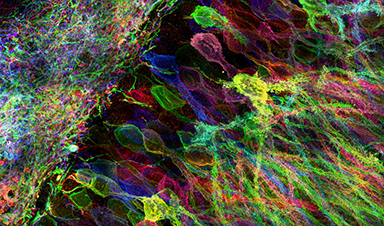Cells contain thousands of messenger RNA molecules, which carry copies of DNA’s genetic instructions to the rest of the cell. MIT engineers have now developed a way to visualize these molecules in higher resolution than previously possible in intact tissues, allowing researchers to precisely map the location of RNA throughout cells.
Key to the new technique is expanding the tissue before imaging it. By making the sample physically larger, it can be imaged with very high resolution using ordinary microscopes commonly found in research labs.
“Now we can image RNA with great spatial precision, thanks to the expansion process, and we also can do it more easily in large intact tissues,” says Ed Boyden, an associate professor of biological engineering and brain and cognitive sciences at MIT, a member of MIT’s Media Lab and McGovern Institute for Brain Research, and the senior author of a paper describing the technique in the July 4, 2016 issue of Nature Methods (“Nanoscale imaging of RNA with expansion microscopy”).
Image credit: Yosuke Bando, Fei Chen, Dawen Cai, Ed Boyden, and Young Gyu
Recent News
According to Researchers, Your Breathing Patterns Could Hold the Key to Better Memory
Breathing synchronizes brain waves that support memory consolidation. A new study from Northwestern Medicine reports that, much like a conductor harmonizes various instruments in an orchestra to create a symphony, breathing synchronizes hippocampal brain waves to [...]
The Hidden Culprit Behind Alzheimer’s Revealed: Microglia Under the Microscope
Researchers at the CUNY Graduate Center have made a groundbreaking discovery in Alzheimer’s disease research, identifying a critical link between cellular stress in the brain and disease progression. Their study focuses on microglia, the brain’s immune [...]
“Mirror Bacteria” Warning: A New Kind of Life Could Pose a Global Threat
Mirror life, a concept involving synthetic organisms with reversed molecular structures, carries significant risks despite its potential for medical advancements. Experts warn that mirror bacteria could escape natural biological controls, potentially evolving to exploit [...]
Lingering Viral Fragments: The Hidden Cause of Long COVID
Long COVID, affecting 5-10% of COVID-19 patients, might be caused by the enduring presence of the virus in the body. Research suggests that viral fragments, possibly live, linger and lead to symptoms. Addressing this involves antiviral treatments, enhanced [...]
Hidden Scars: How COVID Lockdowns Altered Teen Brains Forever
Research from the University of Washington revealed that COVID-19 lockdowns led to accelerated cortical thinning in adolescents, impacting brain development significantly. This effect was more pronounced in females than males, raising concerns about long-term brain health. The study [...]
Simple Blood Test To Detect Dementia Before Symptoms Appear
UCLA researchers have identified placental growth factor (PlGF) as a potential blood biomarker for early detection of cognitive impairment and dementia. High PlGF levels correlate with increased vascular permeability, suggesting its role in the development [...]
Investing Goldman Sachs asks ‘Is curing patients a sustainable business model?’
Goldman Sachs analysts attempted to address a touchy subject for biotech companies, especially those involved in the pioneering “gene therapy” treatment: cures could be bad for business in the long run. “Is curing patients [...]
The risks of reversed chirality: Study highlights dangers of mirror organisms
A groundbreaking study evaluates the feasibility, risks, and ethical considerations of creating mirror bacteria with reversed chirality, highlighting potential threats to health and ecosystems. In a recent study published in Science, a team of researchers [...]
Alarming Mutation in H5N1 Virus Raises Pandemic Red Flags
NIH-funded study concludes that the risk of human infection remains low A recent study published in Science and funded by the National Institutes of Health (NIH) has found that a single alteration in a protein on the surface [...]
Scientists Discover Genetic Changes Linked to Autism, Schizophrenia
The Tbx1 gene influences brain volume and social behavior in autism and schizophrenia, with its deficiency linked to amygdala shrinkage and impaired social incentive evaluation. A study published in Molecular Psychiatry has linked changes in brain [...]
How much permafrost will melt this century, and where will its carbon go?
Among the many things global warming will be melting this century—sea ice, land glaciers and tourist businesses in seaside towns across the world—is permafrost. Lying underneath 15% of the northern hemisphere, permafrost consists of [...]
A Physics Discovery So Strange It’s Changing Quantum Theory
MIT physicists surprised to discover electrons in pentalayer graphene can exhibit fractional charge. New theoretical research from MIT physicists explains how it could work, suggesting that electron interactions in confined two-dimensional spaces lead to novel quantum states, [...]
Inside the Nano-Universe: New 3D X-Ray Imaging Transforms Material Science
A cutting-edge X-ray method reveals the 3D orientation of nanoscale material structures, offering fresh insights into their functionality. Researchers at the Swiss Light Source (SLS) have developed a groundbreaking technique called X-ray linear dichroic orientation tomography [...]
X-chromosome study reveals hidden genetic links to Alzheimer’s disease
Despite decades of research, the X-chromosome’s impact on Alzheimer’s was largely ignored until now. Explore how seven newly discovered genetic loci could revolutionize our understanding of the disease. Conventional investigations of the genetic contributors [...]
The Unresolved Puzzle of Long COVID: 30% of Young People Still Suffer After Two Years
A UCL study found that 70% of young people with long Covid recovered within 24 months, but recovery was less likely among older teenagers, females, and those from deprived backgrounds. Researchers emphasized the need [...]
Needle-Free: New Nano-Vaccine Effective Against All COVID-19 Variants
A new nano-vaccine developed by TAU and the University of Lisbon offers a needle-free, room-temperature-storable solution against COVID-19, targeting all key variants effectively. Professor Ronit Satchi-Fainaro’s lab at Tel Aviv University’s Faculty of Medical and [...]
Photoacoustic PDA-ICG Nanoprobe for Detecting Senescent Cells in Cancer
A study in Scientific Reports evaluated a photoacoustic polydopamine-indocyanine green (PDA-ICG) nanoprobe for detecting senescent cells. Senescent cells play a role in tumor progression and therapeutic resistance, with potential adverse effects such as inflammation and tissue [...]
How Dysregulated Cell Signaling Causes Disease
Cell signaling is crucial for cells to communicate and function correctly. Disruptions in these pathways, caused by genetic mutations or environmental factors, can lead to uncontrolled cell growth, improper immune responses, or errors in [...]
Scientists Develop Super-Strong, Eco-Friendly Plastic That Bacteria Can Eat
Researchers at the Weizmann Institute have developed a biodegradable composite material that could play a significant role in addressing the global plastic waste crisis. Billions of tons of plastic waste clutter our planet. Most [...]
Building a “Google Maps” for Biology: Human Cell Atlas Revolutionizes Medicine
New research from the Human Cell Atlas offers insights into cell development, disease mechanisms, and genetic influences, enhancing our understanding of human biology and health. The Human Cell Atlas (HCA) consortium has made significant [...]
Bioeconomic Potential: Scientists Just Found 140 Reasons to Love Spider Venom
Researchers at the LOEWE Centre for Translational Biodiversity Genomics (TBG) have discovered a significant diversity of enzymes in spider venom, previously overshadowed by the focus on neurotoxins. These enzymes, found across 140 different families, [...]
Quantum Algorithms and the Future of Precision Medicine
Precision medicine is reshaping healthcare by tailoring treatments to individual patients based on their unique genetic, environmental, and lifestyle factors. At the forefront of this revolution, the integration of quantum computing and machine learning [...]
Scientists Have Discovered a Simple Supplement That Causes Prostate Cancer Cells To Self-Destruct
Menadione, a vitamin K precursor, shows promise in slowing prostate cancer in mice by disrupting cancer cell survival processes, with potential applications for human treatment and myotubular myopathy therapy. Prostate cancer is a quiet [...]
Scientists reveal structural link for initiation of protein synthesis in bacteria
Within a cell, DNA carries the genetic code for building proteins. To build proteins, the cell makes a copy of DNA, called mRNA. Then, another molecule called a ribosome reads the mRNA, translating it [...]
Vaping Isn’t Safe: Scientists Uncover Alarming Vascular Risks
Smoking and vaping impair vascular function, even without nicotine, with the most significant effects seen in nicotine-containing e-cigarettes. Researchers recommend avoiding both for better health. Researchers have discovered immediate impacts of cigarette and e-cigarette [...]
Twice-Yearly Lenacapavir for PrEP Reduces HIV Infections by 96%
Twice-yearly injections of the capsid inhibitor drug lenacapavir can prevent the vast majority of HIV infections, according to a Phase 3 clinical trial published Wednesday in the New England Journal of Medicine. HIV pre-exposure [...]
Did Social Distancing Begin 6,000 Years Ago? Neolithic Villagers May Have Invented It
Social distancing may have roots 6,000 years ago, as research shows Neolithic villages like Nebelivka used clustered layouts to control disease spread. The phrase “social distancing” became widely recognized in recent years as people [...]


































Leave A Comment